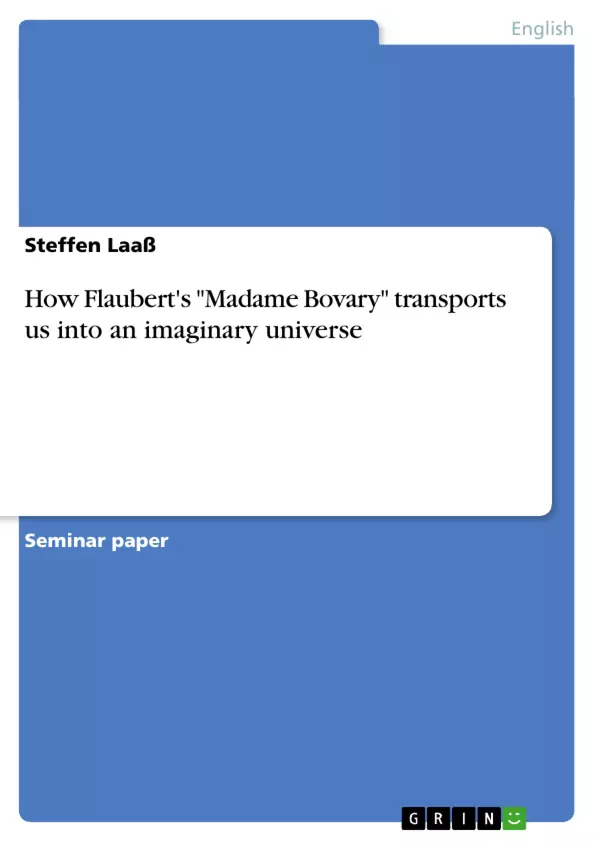And indeed, what is better than to sit by one’s fireside in the evening with a book, while the wind beats against the window and the lamp is burning? … One thinks of nothing … the hours slip by. Motionless we traverse countries we fancy we see, and your thought, blending with the fiction, playing with the details, follows the outline of the adventures. It mingles with the characters, and it seems as if it were yourself palpitating beneath their costumes.
(Madame Bovary, part II, chapter 2)
This quotation elegantly sums up what reading literature should be like: most enjoyable. We find people reading on the train, at the bus stop, in bed, in the waiting room. And every reading is unique. That is why we usually can remember the circumstances under which we have read a book. And the mere fact that people can be carried away by the written word is fascinating – and worth further investigation.
This essay is about reading, to be more precise about reading fiction. It is an attempt to explore how we read, or process, literature. We want to investigate how we comprehend fiction and how we monitor the tracking of characters and events in a story. Doing this, we will have to lay much emphasis on the reader as an individual being fully conscious of what and how he is reading. For this exploration, cognitive poetics with its relatively new way of thinking about literature will provide the necessary frameworks, one of which I will apply and discuss in more detail: Emmott’s contextual frame theory.
One question that I hope I will be able to answer in this paper is: How does fiction transport the reader into an imaginary universe? The approach to this question is not easy as I will have to draw on a number of interrelated disciplines such as linguistics, psychology and philosophy. The text I will ‘exploit’ for this end is Gustave Flaubert’s masterpiece Madame Bovary (1857) which I have a particular relation to. So this essay will also be a very personal evaluation on literary reading.
We will proceed as follows: First of all, we will explore the opening to Flaubert’s text to analyse it on the basis of Emmott’s contextual frame theory (inductive approach). Afterwards, we will apply selected key concepts of this theory to suitable passages of the novel (deductive approach). Then we will engage more fully with some theoretical assumptions of cognitive poetics. Afterwards we will elaborate on the concept of emotion.
Inhaltsverzeichnis (Table of Contents)
- 1. Introduction
- 2. Why Madame Bovary?
- 3. Cognitive Poetics Applied: The Contextual Frame Theory in Practice.
- 3.1. The inductive approach.
- 3.2. The deductive approach
- 4. Discussion..........\li>
- 4.1. World knowledge
- 4.2. Inferences
- 5. Emotions and feelings
- 6. Introspection
- 7. Contextual frame theory and emotions.....
- 8. The transportation of the reader into an imaginary universe.
- 9. Conclusion.
Zielsetzung und Themenschwerpunkte (Objectives and Key Themes)
This essay explores how fiction transports the reader into an imaginary universe. The author uses Gustave Flaubert's *Madame Bovary* to examine the process of reading and comprehending fiction, focusing on the role of the reader in actively engaging with the text. The essay delves into the concept of contextual frame theory, a framework from cognitive poetics, and its application to *Madame Bovary*.
- The process of reading and comprehending fiction
- The role of the reader in actively engaging with the text
- The concept of contextual frame theory
- The transportation of the reader into an imaginary universe
- The emotional impact of literature
Zusammenfassung der Kapitel (Chapter Summaries)
The introduction sets the stage for the essay by discussing the significance of reading and the unique experience each reader brings to the process. The author then introduces the concept of cognitive poetics and its application to understanding how we read and comprehend fiction.
The second chapter explores the reasons why *Madame Bovary* was chosen as the text for this analysis. The author highlights the novel's emotional impact, its readability, and its focus on realistic themes that resonate with readers.
The third chapter examines how the contextual frame theory can be applied to *Madame Bovary*. The author uses an inductive approach to analyze the opening of the novel, identifying the characters, setting, and frame modifications that occur. Subsequently, a deductive approach is taken to further explore key concepts of the theory through selected passages from the novel.
The fourth chapter delves deeper into the theoretical assumptions of cognitive poetics, focusing on the importance of world knowledge, inferences, and emotions in the reading process.
Schlüsselwörter (Keywords)
Cognitive poetics, contextual frame theory, reader engagement, *Madame Bovary*, Gustave Flaubert, fiction, transportation, imaginary universe, emotional impact, literary analysis, reading process, world knowledge, inferences.
- Citation du texte
- Steffen Laaß (Auteur), 2005, How Flaubert's "Madame Bovary" transports us into an imaginary universe, Munich, GRIN Verlag, https://www.grin.com/document/70553



